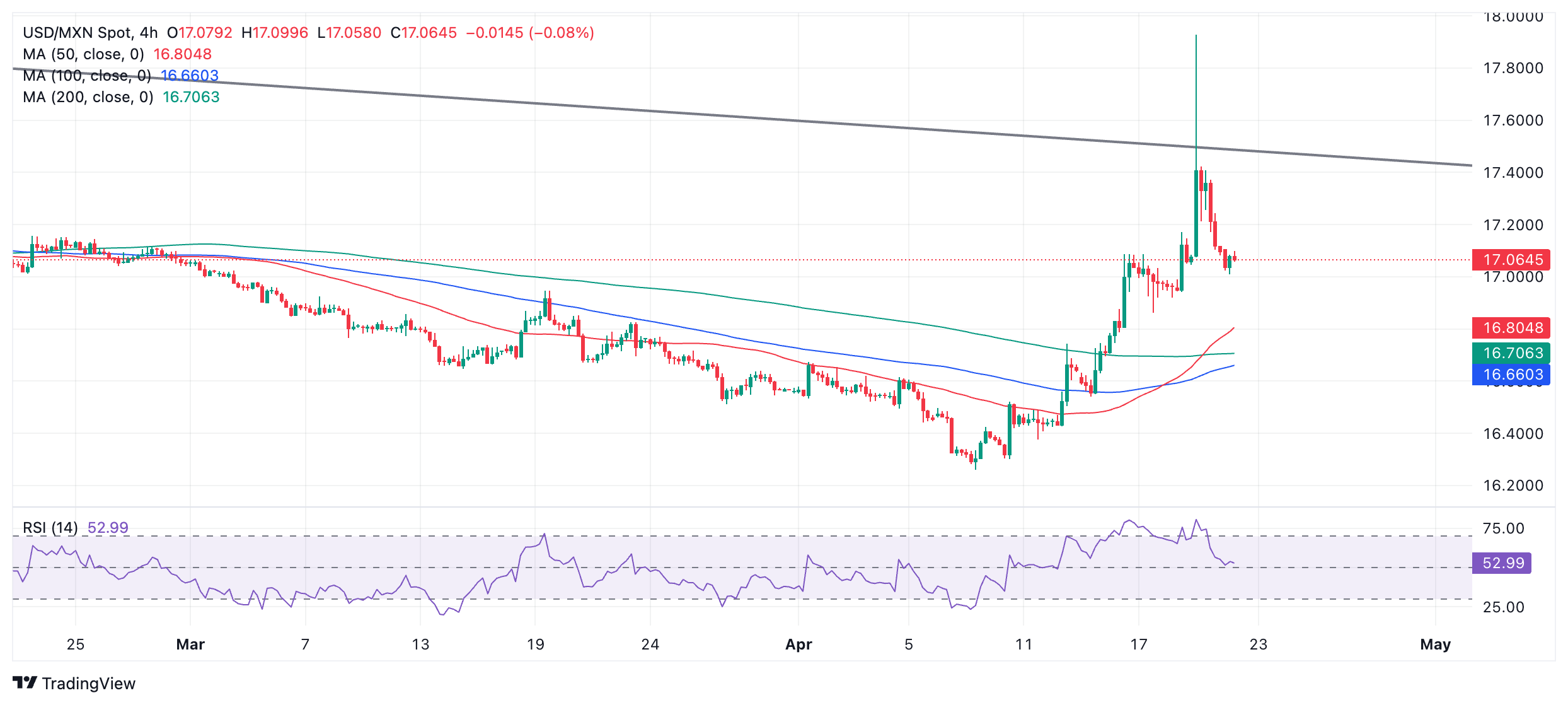- The Mexican peso recovers as tensions in the Middle East temporarily decrease.
- However, several sources of geopolitical risk continue to pose threats to the Peso.
- A new strain of the Omicron variant of the Covid virus is spreading, although symptoms appear mild so far.
The Mexican Peso (MXN), which is especially vulnerable to geopolitical risk, is rising against most of its peers on Monday morning, as relief spreads through markets due to a temporary easing of tensions in the Middle East .
The conflict between Israel and Iran has not worsened as markets feared. The lone Israeli attack on a military base on the outskirts of Isfahan on Friday has not provoked a counterattack from Iran so far, and the Mexican peso has recovered as a result.
From a high of 17.92 on Friday, when fears of an escalation were highest, USD/MXN has fallen to 17.02 on Monday.
Regarding the data, on Monday the economic activity of Mexico will be published, on Wednesday the inflation of the first semester and underlying inflation, and on Friday the trade balance and the unemployment rate. These data are unlikely to affect the MXN much unless they show significant deviations from previous results or estimates.
The Mexican peso remains at risk
The sharp drop in the Mexican Peso at the end of last week was caused by geopolitical risk, which appears to be the most important driver of the currency at the moment.
Although hostilities in the Middle East have temporarily subsided, the threat of future flare-ups still poses a risk to the currency.
According to Financial Times chief foreign affairs commentator Gideon Rachman, Russia, Iran, North Korea and China now constitute an “axis of adversaries” working together against the West. Rachman points out that the military base outside Isfahan targeted by the Israelis is, in fact, a nuclear enrichment center using reactor technology supplied by China.
But the Middle East is not the only potential source of geopolitical risk. Reports of a new strain of the Omicron variant of the COVID-19 virus have also destabilized markets at the start of the new week.
“Although the WHO urges caution, it notes that symptoms related to the new strain have so far been mild. Given that it will take some time to determine the likely impact on the global economy, we believe risk aversion will continue this week,” the analysts say. from private investment bank Brown Brothers Harriman in a Monday note.
A handful of countries have already introduced small social distancing measures, but if the strain begins to spread and pose a more serious health risk, this could pose a new risk factor for investors, leading to a steady flow of funds into havens. safe and out of higher risk assets such as the Mexican peso”.
Technical analysis: USD/MXN stabilizes again
The USD/MXN (the value of one US dollar in Mexican pesos) has retreated after briefly breaking above an important trend line for the long-term downtrend.
The breakout was not enough to reverse the long-term bearish trend, but it did change the outlook in the short and medium-term horizons, which could now be said to have reversed their bearish tenors, favoring long positions over short ones.
USD/MXN 4-hour chart

That said, the new USD/MXN short-term uptrend is already showing signs of weakness as the pullback from Friday's high continues and the lack of new bullish momentum injects price appreciation. The 200-day SMA support at 17.17 also appears to have been broken. A negative close on Monday would confirm a bearish shooting star candlestick pattern on the daily chart.
A decisive break above the trend line around 17.45 would be necessary to provide bullish reconfirmation and trigger a bullish target around 18.15.
A decisive breakout would be characterized by a longer than average daily candlestick piercing above the trend line and closing near its high, or three consecutive green candlesticks piercing above the level.
The Relative Strength Index (RSI) has exited the overbought zone and returned to neutral territory, suggesting a new bullish margin.
However, if the pullback persists, the support of the 100-day SMA at 16.96 followed by the 50-day SMA at 16.82 is likely to provide a support point for the receding price.
Frequently Asked Questions about the Mexican Peso
What is MXN?
The Mexican Peso is the legal tender of Mexico. The MXN is the most traded currency in Latin America and the third most traded on the American continent. The Mexican Peso is the first currency in the world to use the $ sign, prior to the later use of the Dollar. The Mexican Peso or MXN is divided into 100 cents.
What is Banxico and how does it influence the MXN?
Banxico is the Bank of Mexico, the country's central bank. Created in 1925, it provides the national currency, the MXN, and its priority objective is to preserve its value over time. In addition, the Bank of Mexico manages the country's international reserves, acts as a lender of last resort to the banks and advises the government economically and financially. Banxico uses the tools and techniques of monetary policy to meet its objective. Regarding the influence of the central bank on the Mexican peso, a rise in Banxico interest rates tends to strengthen the MXN, while low rates will tend to devalue the local currency.
How does inflation impact the MXN?
When inflation is high, the value of the Mexican Peso (MXN) tends to decrease. This implies an increase in the cost of living for Mexicans that affects their ability to invest and save. At a general level, inflation affects the Mexican economy because Mexico imports a significant amount of final consumption products, such as gas, fuel, food, clothing, etc., and a large amount of production inputs. On the other hand, the higher the inflation and debt, the less attractive the country is for investors. However, depending on the context, high inflation implies higher interest rates from the Mexican central bank (Banxico), which can lead to strength in the Mexican peso.
How does the Dollar influence the Mexican Peso (MXN)?
The exchange rate between the USD and the MXN affects imports and exports between the United States and Mexico, and may affect demand and trade flows. The price of the Dollar against the Mexican Peso is affected by factors such as monetary policy, interest rates, the consumer price index, economic growth and some geopolitical decisions.
How does the Fed's monetary policy affect Mexico?
The exchange rate between the USD and the MXN affects imports and exports between the United States and Mexico, and may affect demand and trade flows. The price of the Dollar against the Mexican Peso is affected by factors such as monetary policy, interest rates, the consumer price index, economic growth and some geopolitical decisions. High interest rates from the Fed tend to strengthen the Dollar, so if Banxico kept rates low while the Fed kept them high, an imbalance in the USD/MXN favorable to the USD would occur.
Source: Fx Street
I am Joshua Winder, a senior-level journalist and editor at World Stock Market. I specialize in covering news related to the stock market and economic trends. With more than 8 years of experience in this field, I have become an expert in financial reporting.







